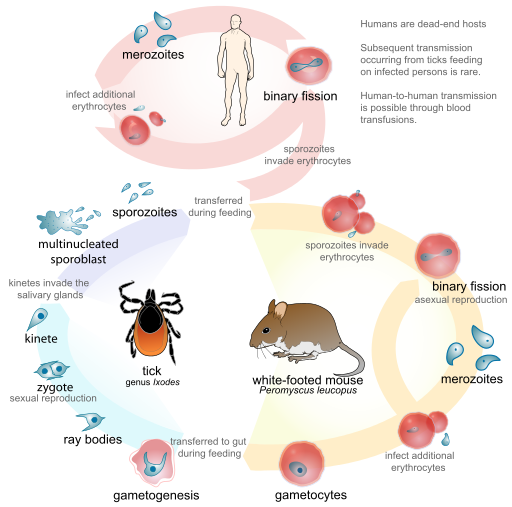When most of the world
is struggling to shed the phobia of mad cow disease, bird flu, monkeypox virus
and Covid-19, an ancient protozoan serpent Babesiosis still wait in ambush
patiently at our cattle farms, outdoor game hunting or on a polo field to
poison us with venom that will take our breath away.
Babesiosis is no baby
as a layman will guess it to be, in fact it’s like malaria of tropical
geographies which is spread by female anopheles mosquitoes, it is spread by
Ixodid ticks in the west especially in the region of Europe and America. Like
all parasitic transmitted diseases Babesiosis has also a vector, carrier and a
host. The vector in this case is Ixodid ticks, the carrier is our cattle and
wild animals and host is humans and animals. Babesiosis is a protozoan disease
which the black Ixodid ticks sucks from the cattle and accumulates in their gut
and further concentrate in their salivary glands and in turn transmits the
infection to humans. Most of the patients cannot even recall that when they
were bit by the tick. The general targets are people living at countryside or
game hunters in the forest. However the disease can further be transmitted
through blood transfusion by an infected person to another person, in desperate
need of blood or in many cases the disease is also transmitted by a mother to her
child in her womb.
The incubation or
dormant period for the disease is generally one to four weeks after which the
disease starts showing its symptoms of weakness, fatigue, depression, fever,
weight loss, headaches, allergic to light, stiffness of muscles, continued
cough, shortness of breath, vomiting, report of abdominal pain and accompanied
by dark urine.
Like Malaria
Babesiosis also targets the red blood cells of our body and destroy them
gradually leading to the mentioned ailments and then after they multiply by
basic cell division, in order to comprehend it briefly in a layman perspective,
red blood cells are transport for the oxygen to various parts in the body and
constant degeneration leads to low red blood cells counts, hence low oxygen
supply in the body leaving us breathless, lethargic, fatigued and with fragile
immune system.
Unlike other disease
Babesiosis shows a unique characteristics in its mortality rate or living ratio
of infected patients and differs according to geographic boundaries of the
continents for example in America only ten percent of the infected patients die
the rest recover with the aid of medical care or in many cases even in the absence
of it while the story in Europe is entirely different and approximately fifty
percent of the patients infected die due to this disease.
Age and sex is no bar
for this disease and can occur equally in male and females of all age groups.
But age groups above fifty are more susceptible to this disease as their immune
system has lived half of its life and portrays a feeble defence against the
onslaught of Babesiosis.
Babesiosis and Lyme
diseases are both tick borne diseases and sometimes people mistake them to be
of similar nature where as in reality Babesiosis present a more severe
infection level in humans as compared to Lyme infections and thus different
levels of treatments are required for both the diseases. On the other hand
patients of both diseases complain history of travel to areas like Nantucket
Island in America, where ironically the disease was first discovered in the
region in 1966, especially during the month of May and September.
Patients suffering
from this disease are fortunate to have a cure for this disease and the regular
procedure of malaria is required to be drilled once the infection is
discovered. Proper medical advice and medicines like Clindamycin (lincosamide
antibiotic) are safest bet for the cure.
Babesiosis is
constantly spanning its wings in other countries like Japan Mexico and China
apart from Europe and America and needs an immediate attention and education
for the people domiciled in other countries of the world so that they are well
prepared with the necessary tools to fight this slow and steady catastrophe as
and when it reaches their doors.
Detection of Babesiosis
Babesiosis or
piroplasmosis is a very dangerous and invasive zoonotic disease (transmitted
between animals and humans) of humans and animals that is spread by ticks.
Although this parasite is widely widespread, it commonly infects rodents,
carnivores, and cattle. However, in recent years, their spread and cross-spread
have increased significantly and has been detected in various species. The
causative agent is the Babesia species.
Babesiosis in goats
Tick-borne diseases of
livestock can be economically devastating therefore husbandry practices and the
availability of vaccination should be made public to farmers, especially in
areas of rural economies.
The infecting agent
that causes Babesiosis in goats is Babesia ovis (B. ovis) common in the Middle
East, Middle Europe, central Asia, Turkey, India and some parts of Africa.
Although not much is known about the disease and spread among goats, it is
generally observed that it spreads in acute circumstances. Information about
its spread and agents spreading the disease is not fully understood. However it
is known that the protozoa destroys red blood cells and causes anaemia.
Currently several anti
protozoa vaccinations are available in the form of imidocarb, derived from
carbanilides. Further treatment could require administration of veterinary
antibiotic called “tylosin”.
Babesiosis symptoms
Most people in the US and other parts of the world infected with babesiosis usually do not experience any symptoms. However, there are symptoms that could easily be mistaken for other conditions such as fatigue, fever, malaise, jaundice, and anaemia. Many of these symptoms can last from few days to several months and usually appear one to four weeks after infection. In individuals who are asymptomatic the disease typically goes away on its own.



No comments:
Post a Comment
Leave your comment below